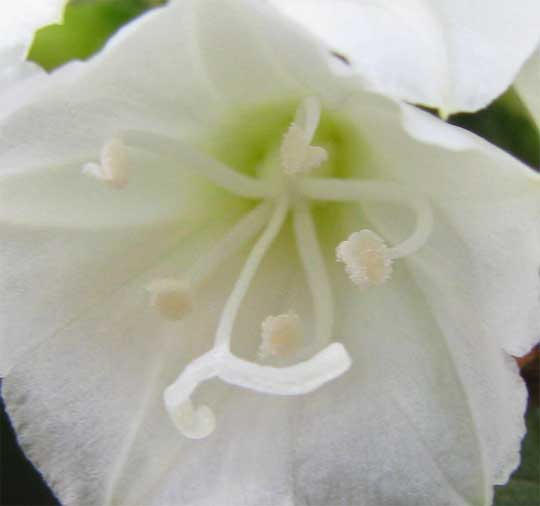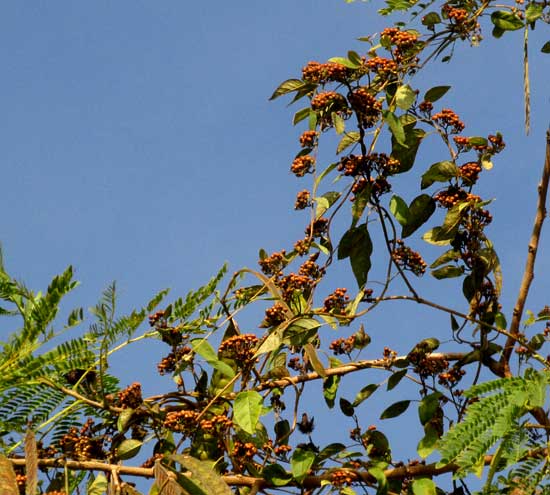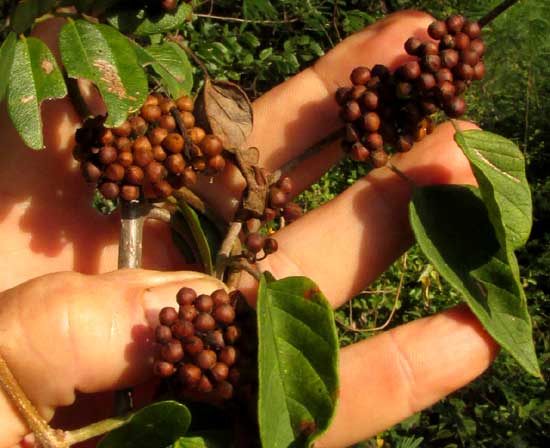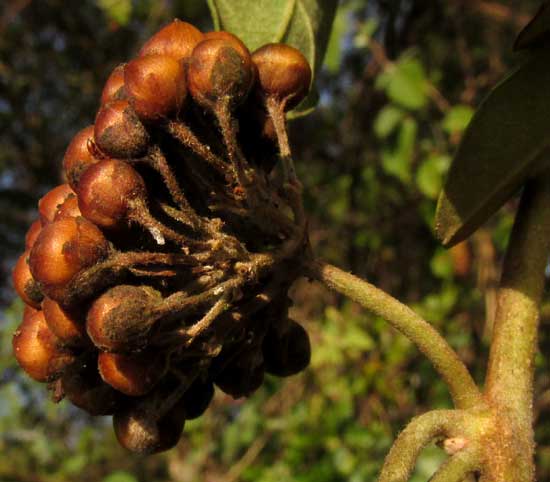Excerpts from Jim Conrad's
Naturalist Newsletter
from the November 24, 2008 Newsletter written in Yokdzonot about half an hour by bus west of Pisté, Yucatán, MÉXICO
elevation ~25m (~82 ft), N20.707°, W88.731°
JACQUEMONTIA/ "LITTLE WHITE BELL"
At the risk of over morning-glorying you, I just have to tell you about yet another morning-glory species, for in many places along roads and in abandoned cornfields it's creating very pretty, viny, snowy-flowered mantles for bushes and trees. That's it below:

Since the vine is basically a tropical species I don't think it has a proper English name; in general people just call it by its genus name, Jacquemontia. In Spanish it's called "Campanita Blanca," or "Little White Bell," because of its small, white, bell-shaped flowers. Five species of Jacquemontia are listed for the adjacent state and I'm guessing that ours is JACQUEMONTIA NODIFLORA.
The morning-glories we've looked at so far have belonged to the genus Ipomoea, which is the main morning-glory genus. A distinguishing feature of Ipomoeas is that their stigmas -- the pollen-receiving zone of the female pistil -- are ± spherical, or "globose." You can see some Jacquemontia stigmas below:

In that picture the five, ± spherical items at the ends of long, slender, inward-curving stems, or filaments, are the stamens' pollen-producing anthers. The lowermost item in the photo, which looks like a white, horizontal bar connected at its middle to a stem arising in the flower's center, is composed of two elongate, slender stigmas. So, Jacquemontia's stigmas are long and slender, not spherical, like's Ipomoea's.
When I first go out in the morning and it's still chilly, Jacquemontia's many flowers are mostly closed, but after sunlight has bathed them an hour or so they begin opening, and by mid morning usually they are as wide open as they can be, and nearly always by then they are just swarming with very busy honeybees.
from the January 28, 2018 Newsletter issued from Rancho Regensis north of Valladolid, Yucatán, MÉXICO;
elevation ~40m (~130 ft), N~20.876°, W~88.170°
TREETOP CLUSTERS OF LITTLE BROWN FRUITS
Along roadsides through the local cut-over, scrubby woods, nowadays treetops bear vines heavy with peppercorn-size fruits, as seen below:

Being a vine bearing heart-shaped leaves and such fruits, it's clear that we're dealing with a fruiting morning glory. However, we have lots of morning glory species in this area, so which is this? A close-up of the handsome fruit clusters helps whittle down the possibilities, as seen below:

A cluster of fruits seen from the side, and showing that the peduncle and stem are covered with low, soft hairs is shown below:

Any morning glory producing so many tightly clustered, capsular-type fruits of such a small size must earlier have borne unusually small, closely packed flowers. Our smallest species of morning glory are members of the genus Jacquemontia, of which so far we've noticed three species in the Yucatan. Of those three species the one with the smallest, most congested flowers is the white-flowered Jacquemontia nodiflora.
Further field marks confirming that these fruits are from Jacquemontia nodiflora, which we call "Little White Bells," include leaf and stem appearance, and the clusters' numbers of fruits seeming to match the numbers of flowers in our pictures showing clustered flowers. Also, the species when flowering strikes me as equivalently abundant relative to the fruiting vines now being seen.
Thousands of pictures of this species' flowers appear on the Internet, but I could find no good ones of the fruits. Now the world can know that the fruits of Jacquemontia nodiflora on a sunny morning hanging in the top of a Uaxim tree are almost decorative in appearance, and are worth noticing.